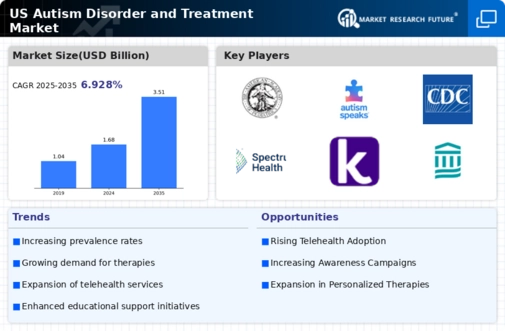Increased Awareness and Advocacy
The autism disorder-and-treatment market is significantly influenced by heightened awareness and advocacy efforts surrounding autism. Organizations and advocacy groups are actively working to educate the public about autism, its challenges, and the importance of early intervention. This increased visibility is leading to greater acceptance and understanding of ASD, which in turn encourages families to seek diagnosis and treatment. Furthermore, legislative initiatives aimed at improving access to services and funding for autism-related programs are gaining traction. As a result, the autism disorder-and-treatment market is likely to see a surge in demand for services and resources, as more individuals and families become informed about available options and support systems.
Government Initiatives and Funding
Government initiatives and funding play a pivotal role in the growth of the autism disorder-and-treatment market. Federal and state programs are increasingly allocating resources to support research, treatment, and educational services for individuals with autism. For instance, the Individuals with Disabilities Education Act (IDEA) mandates that schools provide appropriate services to students with disabilities, including those with ASD. This legal framework ensures that educational institutions are equipped to address the needs of affected students, thereby driving demand for specialized services. Additionally, funding for research into the causes and treatments of autism is expanding, which may lead to the development of more effective interventions. As government support continues to grow, the autism disorder-and-treatment market is expected to flourish.
Advancements in Therapeutic Approaches
Innovations in therapeutic approaches are playing a crucial role in shaping the autism disorder-and-treatment market. Recent developments in behavioral therapies, such as Applied Behavior Analysis (ABA), have shown promising results in improving outcomes for individuals with ASD. Additionally, the introduction of pharmacological treatments targeting specific symptoms associated with autism is expanding the range of options available to caregivers and healthcare providers. The autism disorder-and-treatment market is likely to benefit from ongoing research and clinical trials aimed at refining these therapies. As new evidence emerges regarding the efficacy of various treatment modalities, practitioners are better equipped to tailor interventions to meet the unique needs of each individual, thereby enhancing the overall effectiveness of autism care.
Integration of Multidisciplinary Care Models
The integration of multidisciplinary care models is emerging as a key driver in the autism disorder-and-treatment market. This approach involves collaboration among various healthcare professionals, including psychologists, speech therapists, occupational therapists, and educators, to provide comprehensive care for individuals with autism. By addressing the diverse needs of patients through a coordinated effort, these models enhance the effectiveness of treatment and support services. The autism disorder-and-treatment market is likely to benefit from this trend, as families increasingly seek holistic solutions that encompass various aspects of care. Furthermore, the emphasis on teamwork and communication among providers may lead to improved outcomes for individuals with ASD, thereby fostering greater satisfaction among families and caregivers.
Rising Prevalence of Autism Spectrum Disorders
The autism disorder-and-treatment market is experiencing growth due to the increasing prevalence of autism spectrum disorders (ASD) in the United States. Recent estimates suggest that approximately 1 in 44 children are diagnosed with ASD, indicating a significant rise in cases over the past decade. This growing incidence necessitates enhanced treatment options and support services, thereby driving demand within the autism disorder-and-treatment market. As awareness of ASD expands, families are more likely to seek early diagnosis and intervention, further contributing to market growth. The need for specialized therapies, educational resources, and support systems is becoming increasingly apparent, prompting stakeholders to invest in innovative solutions to address the needs of affected individuals and their families.

















Leave a Comment